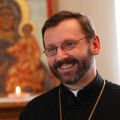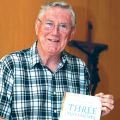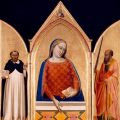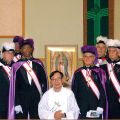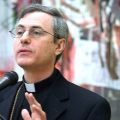Ontario's Catholic school trustees seek change to McGuinty's Putting Students First Act
By Evan Boudreau, The Catholic RegisterOntario’s Catholic school trustees are pressing for changes to Dalton McGuinty’s Putting Students First Act and insisting that Catholic school boards should not be legally bound to new teacher contracts imposed by the government.
OCSTA officials will continue to push for amendments to the act to remove contentious clauses that strip school boards of important management rights pertaining to teacher hiring and student testing, said Bob Murray, OCSTA director of legislative and political affairs.
Under the proposed new law, Catholic boards will be required to operate by more restrictive policies than the province’s public boards. That inequality was created in late August when the government backtracked on Putting Students First and returned to French and public boards the right to negotiate non-salary issues with their unions. But the same right was denied to Catholic boards.
The government had previously done a deal and signed a memorandum of understanding (MOU) directly with the union that represents Catholic teachers, the Ontario English Catholic Teachers’ Association (OECTA). That deal was negotiated without input from Catholic trustees and their boards, and was allowed to stand after the government relented to opposition party demands to amend Putting Students First.
“While the union has signed, the boards themselves, as the legal employer, refused to sacrifice those rights (pertaining to hiring and testing) that are legally theirs,” Murray said. “So, for no reason should they be legally bound to an agreement they didn’t sign.”
Five Catholic boards had previously agreed to accept the terms negotiated between the government and OECTA and, said Murray, those boards are legally bound to honour the contract they signed. But OCSTA believes the other 24 Catholic boards should have the same negotiating rights as the public boards.
“We have these agreements that were not reached according to the legal collective bargaining process,” said Murray, adding that “labour relations rights of employers and employees have been violated.”
The trustees are concerned that granting teacher unions more input in hiring and a greater say in managing diagnostic testing will negatively impact the quality of education. In a statement, OCSTA expressed concern that decisions about education are being made for reasons of political expediency.
“These rights are important because of the impact they have on students and the quality of education delivery,” said Murray
OCSTA officials were to meet with Liberal and opposition party members to make their case for change.
“There will be opportunities for amendments to be put forward and our hope is that the opposition parties will continue to push very strongly to have these two issues fully removed from the legislation,” said Murray. “Our intention and our desire would be for the bill to be amended further to remove those two provisions to be bound to any board at this point.”
According to a government spokesman, a final vote on Putting Students First is not expected before Sept. 10.
Ukrainian Major Archbishop Shevchuk prepares to open synod
By Catholic News ServiceWINNIPEG - The major archbishop of the Ukrainian Catholic Church sent greetings to Canada’s Ukrainian Catholics as he prepared for a multicity visit that includes leading the Church’s Synod of Bishops.
Major Archbishop Sviatoslav Shevchuk of Kiev-Halych, Ukraine, said the synod would “fill all our Canadian community with the special blessing of the Holy Spirit, blowing the fresh wind of this Spirit into the sails of the Ukrainian Church in this country.” His remarks were contained in a message read in Canada’s Ukrainian Catholic churches Sept. 2.
The annual worldwide synod of Ukrainian Catholic bishops is being held in Winnipeg Sept. 9-16 to mark the 100th anniversary of the arrival of Ukrainian Catholic Bishop Nykyta Budka in Canada in 1912. The bishop, now beatified and known as Blessed Nykyta, laid the groundwork for a united Ukrainian Catholic Church in Canada, gathering the scattered clergy, religious and laypeople.
Ukrainian Catholic Archbishop Lawrence Huculak of Winnipeg said the synod would renew ties between the Ukrainian Catholic Church in Ukraine and Canada and would “affirm the struggle of ... the early pioneers who did so much to establish our Church in Canada and bring it to what it is today.”
In his message to the Canadians, Shevchuk appealed for their prayers and support for the synod members. He also expressed thanks for the Canadians’ preservation of the Church’s religious and cultural traditions and for their help after the Ukrainian Catholic Church — a Byzantine rite — began emerging from decades of communist oppression in Ukraine late in the 20th century.
The major archbishop began his visit in the Vancouver area Aug. 31 before travelling to Winnipeg. After the synod, he is scheduled to visit Saskatoon and then speak to the Canadian Conference of Catholic Bishops at its 2012 annual plenary in Sainte-Adele, Que., Sept. 24.
He visited Ukrainian Catholics in the Edmonton area in June and will visit Toronto and eastern Canada early in 2013.
Brian Brown bridges three religions in new book launching
By Michael Swan, The Catholic RegisterTORONTO - Faith is a difficult subject to bring up with our children, our own flesh and blood. How many of us would endure earnest talk of faith from friends? A combination of courage and psychopathology is necessary before most Christians can talk about faith with strangers. So, what chance does interfaith dialogue really have?
Brian Brown is not so easily dissuaded. The United Church minister and prolific author is convinced all we need is the right starting point.
“The most basic approach is to go to each others’ Scriptures,” he told The Catholic Register. “If we’re to understand what each other aspires to be, the place to begin is each others’ Scriptures.”
That’s the premise behind Three Testaments: Torah, Gospel and Quran. Brown has assembled Muslim, Christian and Jewish scholars to introduce modern, readable translations of the three texts. The scholars explain how the holy books of each community are used and understood within the faith they represent.
In the 21st century the three Abrahamic faiths do not occupy separate patches of the globe, or even separate social spheres. The three major faiths of the West rub shoulders daily, and we have the wars to prove it. For Brown, getting past the dialogue of caricatures, suspicion, fear and resentment is a matter of life and death.
“It’s an antidote to the burning of the Quran,” he said.
It’s not just terror attacks in far off capitals, or sick minds blowing up cars and shooting up theatres, that has Brown concerned. Ordinary Christians, Muslims and Jews have all been touched by the toxic stew of interfaith ranting, slander and innuendo.
“I had a person tell me they were a little afraid to go to the hospital in Niagara Falls because most of the doctors are Muslim. These are good, sensible Christian people who are influenced by those bomb makers and now need to hear from the Scripture authorities,” he said. “Eighty per cent of Christians — and I’m guessing 80 per cent of Muslims and Jews — are so negatively impacted by the bombers and bloggers that good, proper-thinking Christian people getting e-mails that are cockeyed develop strange notions about their Muslim neighbours or their Jewish neighbours.”
David Bruce, a United Church minister for 25 years who is now the lay Catholic director of The Good Neighbours’ Club for homeless men in Toronto, introduces the Gospel in Three Testaments. With doctorates from California’s Fuller Theological Seminary and Toronto’s University of St. Michael’s College, Bruce believes the Three Testaments approach works because it’s based on solid scholarship and aimed at ordinary, intelligent readers.
“Anybody who picks up a National Geographic and enjoys the articles should be able to enjoy Three Testaments,” he said.
It’s also successful because the book isn’t trying to cram three different religions into a single test tube of kind and fluffy thoughts.
“There’s an increasingly large proportion of Western Christianity that says there really isn’t any difference in the world religions if you boil it all down,” said Bruce. “We’re not saying that. We’re saying that there are real differences but that doesn’t mean we can’t stand side by side and listen to one another.”
The book is meant to be read by people of faith. It’s not an outsider’s sociological analysis of religion as a curious phenomenon among certain classes of people.
“All of this is written by believers to believers of other faiths,” said Bruce.
As such it’s the antidote to common distortions that hijack religion, said Brown.
“Scriptures are abused and can be made to say things. This project is a joint project of Christian, Jewish and Muslim scholars to run counter to that, to say, ‘Let the Scriptures speak for themselves.’ ”
The book is as much a cause as it is literature. Brown wants it read in seminaries and on university campuses. The book launch will take place in seven cities, beginning at Ground Zero in New York. New York launch events include a Sept. 9 interfaith rally in St. Peter’s Church next door to Ground Zero. In Washington Sept. 10-12 during the thick of the presidential campaign the Three Testaments launch at the Canadian Embassy will feature ambassadors, religious leaders and Amir Hussain, editor of the Journal of the American Academy of Religion who wrote the foreword to Three Testaments. In Dallas-Fort Worth Sept. 12-13 the book will be presented to the George W. Bush Presidential Library. In Los Angeles Sept. 14-15 the launch brings together Christians, Jews and Muslims for Temple Beth Am’s Shabbat service. The Jesuit University of San Fransisco host the Abrahamic faiths for an event Sept. 16-18. Kazi Publications, the most important Muslim publisher in America, hosts the Chicago launch Sept. 19-20. Toronto gets its turn Sept. 23-30 at the Royal Ontario Museum.
The book also has something to say to people who dismiss religious thinking or think religious people incapable of solving religious conflict, said Bruce.
“There is a stereotype out there that anybody who is actually committed to one of the three great Western faiths has somehow parked at least a section of their brains — they’ve put it in neutral. That’s just not the case,” he said. “In fact, the best scholarship in all three religions is by those who actually practise the faith.... It’s important for the three Abrahamic religions to hear each other on their own terms. When you bring them so close together in a single volume, they don’t really have any choice.”
Over-consumption of oil products, not the pipeline, is the real issue
By Evan Boudreau, The Catholic RegisterIt isn’t the construction of the Northern Gateway pipeline that raises great concern for Bishop Gary Gordon. Rather it is the perception that the pipeline is necessary in the first place.
Gordon, bishop of the Whitehorse diocese, said the proposed pipeline symbolizes society’s relentless hunger for oil, and that worries him.
“We’ve got a great problem with the sin of coveting and we export it all over the world,” said Gordon. “That’s kind of a root issue, we’re being driven by an insatiable need to have more but it’s not solving our deepest yearning and hungers.”
Enbridge has been working on its pipeline proposal since the early 2000s but didn’t formally make a public announcement until 2006. The project currently aims to build a 1,177 km sub-surface pipeline from Bruderheim, Alta., to Kitimat, B.C., and its port on the Pacific Ocean.
Since plans were announced, numerous parties have voiced environmental concerns, citing deforestation, wildlife habitat destruction and potential Pacific coast spills due to the treacherous waters near the port.
The religious voice has not been silent either. Recently the United Church of Canada, the country’s largest Protestant denomination at about three million strong, publicly opposed the pipeline expressing similar fears. And the Anglican bishops of British Columbia and the Yukon issued a statement questioning the integrity of the pipeline’s environmental impacts, while Presbyterians representing 28 parishes in British Columbia’s Lower Mainland also made their voice heard. They wrote to Prime Minister Stephen Harper criticizing the government for weakening environmental reviews, citing the same concerns as their United and Anglican brethren.
The Canadian Conference of Catholic Bishops is still considering if it will release a public statement regarding the issue. The matter came up for discussion Aug. 22 when the CCCB executive met outside Calgary, but there has been no public comment to date.
But there’s still a missing piece of the puzzle, said Gordon, and that makes things more problematic.
“I don’t know if we (should be) taking a position of opposing it. We (should be) taking a position of let’s give this a longer second look and a longer view on the real outcomes for Canadians,” he said, hoping the CCCB takes this stance. “We need to check our consumption and figure out a more simple way of living.”
Gordon’s not saying that we need to abandon every byproduct of the oil industry — he isn’t willing to give up his V8 4X4 Toyota Tundra and doesn’t expect anyone else in North America to ditch their ride. Rather, he’s suggesting that we re-evaluate how we use, and at what rate we consume, oil-based goods such as gasoline.
It’s an idea wholeheartedly supported by Dennis Patrick O’Hara, director of the Elliot Allen Institute for Theology and Ecology, as well as an assistant professor of theology, at Toronto’s University of St. Michael’s College.
“We wouldn’t be needing some of these (pipelines) if people weren’t consuming so much and if people weren’t so wasteful with resources,” said O’Hara, adding that oil companies are not to blame.
“We’re building this (pipeline) because we have a voracious appetite for this oil. That’s a part of the conversation that I’m not seeing or hearing.”
According to Statistics Canada, the annual gross sale of gasoline rose by 1.5 per cent in 2011 to 42.1 billion litres, marking the third consecutive increase despite prices rising at the pumps for Canadians.
This statistic highlights O’Hara’s, and Gordon’s, point that what is good for the economy is not always good for the environment — a point both men said is hard for Canadians to fully grasp.
“We have a petroleum-based economy and that’s not going to be changed overnight,” said O’Hara.
While profits are measured quarterly, the payoffs of environmentally friendly living aren’t truly seen for many years.
“We’ve got a cultural mindset that is set against, it is contrary, to the very thinking that we need for the kind of issues that we have now,” said O’Hara. “With climate change you improve your behaviour and you’ll see the benefits about 35 years later. It’s not that if you behave well today things are going to be better tomorrow.
“Things are actually going to get worse before we see the benefits and things getting better.”
A necessary commitment to consumption reduction Gordon said will only be successful if parishioners, who are the consumers, have their parish’s support.
“We’re shepherds of souls,” said the bishop. “The sacrifices of a simpler life are quite daunting for most of us.”
Unlocking miracles with Special Olympics
By Michael Swan, The Catholic RegisterTORONTO - St. Brigid’s parish just north of Danforth Avenue in Toronto’s east end doesn’t just believe in miracles. They are witnessed there weekly.
On Monday nights through the school year, St. Brigid’s invites the Special Olympics into the school gym, right next door to the church. Accompanied by Grade 8 student volunteers from St. Brigid’s Catholic School, an average of about a dozen Special Olympians and their parents play basketball, variations on tag and duck-duck-goose.
It’s an hour-and-a-half of fun, but it’s serious fun.
Intellectually disabled athletes as old as 12 and 13 have spoken their first words at Special Olympics, said coach and organizer Linda Ward.
“It’s like something unlocked,” she said.
“It’s very important for kids,” said Ariel Samuel-Charles’ mother Marina. “Ariel has Down’s Syndrome and it’s very important to keep her active.” The free program that allows 13-year-old Ariel to play and socialize comes as a welcome relief for Marina.
“Most programs are very expensive,” she said. Horseback riding, basketball and weekly swimming lessons for Ariel eat up a big chunk of the family budget, but they’re still not enough, said Marina.
Often the people who appreciate the miracles on the gym floor most are parents. “To see their kids laugh and having fun like everybody else, it’s like a vacation,” said Ward. “It’s all they want for their kids.”
Lina Cornacchi has seen her son Luigi learn new words at the age of 41. The program improves his balance, his co-ordination and his mood.
When asked why the parish should be involved in Special Olympics, Fr. Carlos Augustos Sierra Tobon just points to Luigi. On Sunday mornings after Mass, Luigi’s first question to Tobon is about Special Olympics. Every week he wants to be sure the program is on.
“Luigi has learned new words and new games,” said Lina. “When he knows all the new people, he’s very happy.”
The experience isn’t just new and exciting for the Special Olympians. Student volunteer Jack Kelly found the experience eye-opening.
“I didn’t know what to expect. You learn patience, definitely,” said Kelly. “It’s a different experience. I’ve never been around kids like this before.”
Without Special Olympics Geoffrey Fantaske’s life has a tendency to become much more narrow.
“He’s all too happy to get on his little iPad 15 hours a day,” said Ward.
Ward is really looking forward to this fall, when the St. Brigid’s Special Olympics program will go into its second year. Now she has a core of Special Olympians who have experienced the basics and may be ready to move on to more complex and competitive activities.
“It will be immediate, that trust factor,” she said.
Eventually the St. Brigid’s Special Olympians will have the opportunity to compete at regional, national and international Special Olympics.
Renaissance revealed at Art Gallery of Ontario this spring
By Michael Swan, The Catholic RegisterTORONTO - Christian artists over the past couple of millennia have understood you can paint a picture about God but you can’t paint God. In Florence in the first half of the 14th century artists discovered a whole new way of talking about God — new techniques, new subject matter, new insights which taken together became the Italian Renaissance.
This spring the Art Gallery of Ontario invites us into Florence in the decades before 1348 — the year the black plague wiped out 60 per cent of the population. “Revealing the Renaissance: Art in Early Florence” will bring together altar pieces and manuscripts directly from Florentine churches, the collections of the J. Paul Getty Museum in Los Angeles and the AGO. Co-produced by the AGO and the Getty, this major new exhibition runs March 16 to June 16, 2013.
“The show is irreducibly about faith,” said AGO curator Sasha Suda. “The stories of the Christian faith are certainly being told in the works of art and that’s certainly important to many people. That will speak to them. That will be crucial to them in the experience of the show.”
The Italian Renaissance, more than any other art movement, stocked the shelves of Christian imagination in the West with images of what angels, the Blessed Virgin, Jesus and the saints are supposed to look like. Our mental pictures of heaven, hell and purgatory were first painted in Florence. This art was a clear break from the static, two-dimensional, flat images of previous centuries.
From the late 1200s to the mid-13th century there was a revolution taking place in Florentine workshops fueled by new money, culture wars, globalizing trade and easy credit. It was, said Suda, an age of anxiety and an age of possibility.
“It’s a show about faith in art to communicate anxieties, fears, hopes and most of all desire,” she said.
The mendicant orders, first Dominicans and then Franciscans, had been established more than a century earlier. By the beginning of the 14th century the orders were a force throughout Europe. In Florence they were each building a major basilica. The Dominicans were erecting Santa Maria Novella at one end of the city and the Franciscans had Santa Croce at the other.
“They are kind of in this competition with each other, with each putting their particular mendicant ways of life forward,” said Getty Museum curator Christine Sciacca.
The friars had something to say about the ultimate purposes of wealth and power which stood in opposition to the corrupt, self-aggrandizing wealthy families of the city — the families that Dante Alighieri was skewering in the Divine Comedy, written in Florence in the years leading to Dante’s death in 1321.
The mendicants were employing every artist they could find to carry their message. Giotto di Bondone, Bernardo Daddi, Pacino di Bonaguida and an army of others produced manuscripts, panel paintings, architectural designs and more for the new churches and for confraternities of lay people who attached themselves to the orders. The new art expressed the civic pride of Florentines who, thanks to trade across the Mediterranean with the emerging Ottoman Empire, were enjoying new wealth from expanding banking and textile industries.
While the Florentines were certainly proud of their city and not averse to flaunting their wealth, they had doubts. What was all this money doing to their souls? How was this new wealth leading them toward or away from ultimate salvation?
“With the mendicant orders, a really rich spiritual culture lives alongside and thrives alongside this more secularized practice and usage of religious art,” said Suda.
The Franciscans and Dominicans became closely associated with humanism, the literary and philosophical movement at the base of the Renaissance.
“(Humanism) is reflected in the art of the time, where instead of the gothic cathedrals where man was lost in the infinity of God we have an architecture based on human proportions,” said Dominican art historian Fr. Marius Zerafa in an e-mail to The Catholic Register. “Instead of the symbolism of Byzantine art we have the representation of biblical events, lives of the saints and eventually portraits of men and women.”
Franciscan and Dominican preachers urged people to enter the life of Christ by every means possible — from creche scenes assembled on hillsides to evocative preaching. They commissioned art with the same purpose.
“You have people like Giotto... making the scenes much more believable, using three dimensions so you get sort of sucked into that scene, so you can imagine all the details happening right in that one scene,” said Sciacca. “It was a very visceral thing.”
The literary precursor of Giotto’s paintings was the Meditationes de Vita Christi by Pseudo-Bonaventura, an anonymous Franciscan.
“In the early 14th century people are way more interested in this idea that there could be a correlation between their own lives and Scripture,” said Suda.
“That’s why you get the narrative painting taking off as well, because you could stand in front of these paintings and it becomes an experience of what was happening,” said Sciacca.
Sciacca and Suda’s study of 14th-century Florence has mapped out a crucial link between manuscript illumination and larger panels painted for display in churches. Pacino di Bonaguida pioneered new techniques and materials that made their way into both miniature book illustrations and large paintings.
From one age of anxiety to another, these 700-year-old works have power over 21st-century viewers, said Sciacca.
“They’re just going to react to beauty, first of all,” she said. “But on top of that they’re going to know these stories by looking at these different scenes — just by looking.”
These aren’t pictures just to be analysed by esthetic purists. They are part of the spiritual life of the Church.
“A lot of these things are coming from churches where they still are in use. That’s going to be really interesting. They still live and breathe as religious objects.”
Windsor board disputes findings that led to provincial supervision
By Evan Boudreau, The Catholic RegisterThe Ontario Ministry of Education's decision to place the Windsor-Essex Catholic District School Board under provincial supervision is not sitting well with the board's trustees.
Deloitte and Touche LLP, an independent auditing, consulting and tax firm, produced a report for the Ministry of Education that detailed the various deficit-reduction shortcomings for the board's most recent budgets. It suggested the board appeared willing to cause labour disruption to balance its budget this year.
Despite board chair Barb Holland repeatedly going on record stating the board has no intention of forcing a labour disruption, the Ministry of Education accepted the Deloitte report Aug. 28 and promptly appointed Norbert Hartmann as supervisor.
"The decision to place the board under supervision was the direct result of the WECDSB's inability to meet its financial obligations," said Gary Wheeler, a ministry spokesperson. "In addition, the minister was troubled by the concerns outlined in the Deloitte report about the willingness of the board to endure a strike in order to meet its financial obligations."
The board has failed to balance its books in five of the past six years.
Looking at the 2012/2013 budget, tabled with a projected $3.3-million surplus, the report "determined that there are significant risks in achieving all of the budget-reduction targets. Rather, we believe that there is a significant risk the school board will post a much smaller surplus of $0.7 (million) or even a deficit of up to $1.5 (million)."
A main criticism was that the projected figures, while optimistic, place too much weight on the results of collective bargaining agreements.
Holland doesn't agree with this point.
"You don't do your budget based on goals you'd like to achieve with a particular employee group," she said, adding that much of the predicted surplus came from lean administrative wages. "When we went into the budgeting process this year we were fully aware that ... contracts would expire by the end of August. The majority of our budget was based on what we felt was easily achievable in other budget lines."
What truly troubles Holland is not the accuracy of the statements made in the report, it is the speedy appointment of a supervisor just hours after the government received the report.
"I continue to be frustrated by the fact that a report had been put out and that we had no opportunity to discuss that report with the writers to challenge the findings," said Holland. "There's a lot in that report that I would like to challenge because things that are very positive for our board over the last six years have been portrayed as very negative in an effort to diminish the standing of the board of trustees and in an effort to justify the ministry's actions."
The Ontario Catholic School Trustees’ Association expressed similar sentiments. On Aug. 29 OCSTA president Marino Gazzola sent a letter to Minister of Education Laurel Broten.
"Although we do not challenge the statutory authority, we most strongly object to the way in which it has been exercised," wrote Gazzola. "As a matter of procedural fairness, the Windsor Essex Catholic District School Board had a right to expect some dialogue with you and your staff before taking such a draconian step in implementing the recommendations of the investigator.
"We wonder how it is possible, Madam Minister, that you could have had time on Aug. 28 to have given thoughtful consideration to the investigator's report before presenting your recommendation to the Lieutenant Governor in Council, and how the Lieutenant Governor in Council could have had time to give thoughtful consideration to your recommendation, all before the first 11 hours of Aug. 28 had elapsed."
Despite their differences, both trustees and the government have one source of common ground — parents.
"I want the parents to know that it is the board’s intent to continue to represent them," said Holland. "We have no intention of abandoning our ratepayers."
"The Minister has asked the supervisor to work to ensure that parents continue to have input and a meaningful role in decision-making at this board," said Wheeler. "Parents will also be able to continue to work with local trustees who will be free to carry out individual responsibilities in local communities and at school events."
Hartmann officially takes up his position with the board Sept. 4. In 2008 Hartmann was appointed supervisor of the Toronto Catholic District School Board when it became the first Ontario school board to be taken over by the province.
Holland has already spoken with Hartmann about his plans.
"I have just spoken to the supervisor and we have agreed to meet in the very near future to establish a fair and reasonable way to work within established parameters," said Holland. "I am pleased with that."
Knights’ prayer program brings Our Lady of Guadalupe across Ontario
By Evan Boudreau, The Catholic RegisterTORONTO - Icons of Our Lady of Guadalupe reached Toronto in late August marking the halfway point on the paintings’ first north to south provincial prayer program facilitated by the Knights of Columbus.
“(The prayer program) has covered the whole top of the province and it’s working its way through southwestern, southern and southeastern (Ontario),” said Joe Salini, the Knights state deputy for Ontario. “Once we do the complete circuit we’ll do it again. We are hoping to do that but we just aren’t sure if there is enough time.”
The icon was in Toronto Aug. 22-28 at Epiphany of Our Lord parish.
According to Salini, the Knights became involved with the Basilica of Our Lady of Guadalupe in Mexico several years ago through supreme knight Carl Anderson. He developed such a strong connection to Our Lady of Guadalupe, the only apparition of Mary to appear in Mexico, that the Knights adopted her as the fraternal order’s patroness.
As a way to honour their new patroness, the Knights commissioned the production of multiple replica paintings of the relic located in the basilica with the intention of having them travel across their 72 jurisdictions. Enough copies were made that larger jurisdictions, such as Ontario where there are 13 dioceses, were able to circulate several icons. Each one was painted in Mexico and signed by the rector of the basilica. Pope Benedict XVI has also blessed the icons.
Currently eight are travelling across the province making prayer-service stops at parishes where the Knights are represented. The Knights have issued invitations to anyone who wishes to see the icons.
“If we only invited our own parish, that would not be the right objective of the purpose of this. It is to gather as many as possible from the neighbouring parishes also,” said secondary Knight Val Danukarjanto, who is also a deacon at Epiphany of Our Lord. “The focus of Our Lady of Guadalupe prayer program is to pray for life, to defend the sanctity of human life.”
Danukarjanto turned to the history books, and some symbolism, to explain the connection between Our Lady of Guadalupe and the pro-life movement. Appearing to a peasant named Juan Diego in the 1640s, the apparition spoke to him in the native language Nahuatl requesting a church, which became the basilica, be built on the Hill of Tepeyac, Mexico. It is said that she described herself using the term “coatlaxopeuh,” which loosely translates to “the one who crushes the serpent.” At the time “the serpent” symbolized the Aztecs, who frequently performed human sacrifices, because of the elaborate use of snake images within their temples. Several years after completing the basilica many of the natives converted to Christianity.
“The role of Mary as Our Lady of Guadalupe in this century is to crush the serpent and end our own era’s resumption of human sacrifice through approved abortion,” said Danukarjanto. “Prayer is our most powerful weapon against contraception, abortion, euthanasia and other attacks against the sanctity of human life.”
He isn’t the only one to see this connection. In 1999 Pope John Paul II proclaimed Our Lady of Guadalupe the protectress of unborn children as well as the patroness of the Americas and empress of Latin America.
This is the 15th time the Knights have facilitated a prayer program where a sacred image is the focal point, the first occurring in 1979, which also focused on Our Lady of Guadalupe.
Since the current tour began last fall the icons have made more than 100 stops. About 15,000 people have visited, a number expected to drastically increase, said Salini, now that the journey has taken them to the more densely populated southern region of the province.
Help needed for family of Down syndrome girl arrested under Pakistan's blasphemy laws
By Deborah Gyapong, Canadian Catholic NewsOTTAWA - The family and community of an 11-year-old girl with Down syndrome who was arrested under Pakistan's draconian blasphemy laws face threats of mob violence and burning, warns International Christian Voice (ICV).
ICV founder and chairman Peter Bhatti said Rimsha Masih's family and much of her 1,500-strong Christian community is in hiding because extremists have said that because the girl burned pages of the Koran her whole family must be burned.
"We request that the rest of the Muslim community come forward to help the Christians of Pakistan," Bhatti said. He also appealed for financial assistance for the displaced families.
Bhatti is the older brother of Pakistan's assassinated Minorities Minister Shahbaz Bhatti, the first Christian to hold a cabinet post in the Pakistan government. He was the second prominent political leader in Pakistan to be assassinated by extremists after publicly speaking against the blasphemy laws. His brother, Dr. Paul Bhatti, is now acting as an advisor to the Pakistan government on religious minorities.
Shahbaz Bhatti was ambushed by gunmen on March 2, 2011, only two months after the slaying of Punjab governor Salmaan Taseer.
Masih was charged under the blasphemy laws and put in jail, a move that drew condemnation from Canada's Foreign Affairs Minister John Baird.
"I am deeply troubled by reports that a young girl with developmental disabilities has been arrested for alleged blasphemy in Pakistan and that her family faces threats of violence," Baird said in a statement. "Canada is concerned about the safety of the girl, her family and their community. We have learned that local religious leaders are working together with authorities to calm the situation.
"We urge Pakistan's political and religious leaders to continue to co-operate to protect the family and community," he said. "Canada strongly condemns any act of religious persecution. We urge Pakistan's government to ensure equal rights for all Pakistanis, including members of minority communities."
ICV, founded to provide support for persecuted Christians and other religious minorities in Pakistan, is holding a fundraising dinner Sept. 14 to raise money for the persecuted community.
Bhatti also expressed alarm over the brutal slaying of a 14-year-old Christian orphan from Faisalabad, a city 255 km south of Islamabad. Suneel Masih's mutilated body was discovered Aug. 21 with his nose, ears and tongue removed and acid splashed on what remained of his face. His limbs had been pulled off. Internal organs, including his liver and kidneys were also removed. The boy had gone into a local market to buy a shirt when he disappeared.
Christians are not the only vulnerable minority in Pakistan. Hindus and some Muslim groups outside the mainstream are also targeted, according to news reports.
Fabbro to open London's Walk for Jesus despite controversy surrounding organizer
By Evan Boudreau, The Catholic RegisterThe London diocese will be participating in Saturday's Walk for Jesus despite recent media reports claiming the walk's co-organizer is anti-Muslim.
At 9 a.m. Bishop Ronald Fabbro will give the opening blessing and prayer to an expected 5,000 people before the 1.7-km journey across Dundas Street to Victoria Park where Prayer Fest — a mixture of guest speakers, live music and symbolic ceremonies — will be held.
But the diocese first reconsidered its participation after the media storm in the southwestern Ontario city caused some headaches for the diocese. Media reports framed G.J. Rancourt, who is co-organizing the Walk for Jesus and is director of Prayer Fest, as anti-Muslim for comments he made in 2010 when he was a candidate for the Christian Heritage Party. Rancourt said the quotes that caused the controversy were strategically selected to "sell papers" and characterized him unjustly. He said he spoke out against sharia law, and not Muslims.
"We were seeking to get some clarification on what our involvement was ... and whether or not it would be something that the bishop would continue to do," said Mark Adkinson, spokesperson for the London diocese. "The bishop is just doing the opening prayer at the Walk for Jesus. That's basically the extent of the bishop's involvement and the diocese's involvement."
The diocese became involved with this year's walk after a parishioner, who helped organize the event last year, mentioned his role to his priest. Word then travelled up through the ranks eventually catching Fabbro's interest. The bishop agreed to open the Walk for Jesus but didn't commit to Prayer Fest because it had no Catholic-specific link.
Although separate events, the similarities between them, primarily the theme of unifying Christian faiths by praising Jesus, and their close proximity helped develop the perception that the two were one and the same.
"At that point there wasn't a clear distinction between the two events," said Adkinson, explaining why the diocese originally reconsidered its participation.
Concerns arose early in the week when a local paper published old quotes from Rancourt.
Rancourt said people may be confused over his comments because he didn't draw the distinction between Islam and sharia clearly.
"I'm not beating up on Muslims because to beat up on Muslims wouldn't be fair," said Rancourt. It is sharia law that he thinks shouldn't be allowed in Canada, not Muslims. "Let's not confuse Muslims with sharia because there are Muslims that don't practise sharia."
Rancourt says the practise of sharia law — a moral code and religious law of Islam — is a massive human rights violation, contradictory to Canada's Christian principle-based laws and a lifestyle unwelcome in this nation. He said 170 million people, mostly Hindus and Christians, have been killed around the world because of sharia law.
But at the end of the day Rancourt said his 2010 comments should have nothing to do with Prayer Fest or the Walk for Jesus.
Call it what you want, a misunderstanding, misrepresentation or innocent ignorance, London's bishop didn't want the Church to suffer a black eye, Adkinson said.
"The bishop was taking the reports quite seriously and felt that he had to come out and clarify what his involvement was and also put out a public statement just to be clear on what he was going to be and what he was going to emphasizing this weekend," said Adkinson.
Toronto Maple Leaf dreams come alive for St. Gregory’s grad Matt Finn
By Allison Hunwicks, The Catholic RegisterTORONTO - It's mid-summer at the MasterCard Centre in south Etobicoke, and a Toronto Maple Leafs' prospect game is about to get underway. Some of the most talented young hockey players in the world are powering across the ice for the pre-game warm up. Sporting the blue and and white of the hometown Leafs, some names are already familiar to fans, and all are currently under the scrutiny of scouts in the National Hockey League's biggest market. Leafs' general manager Brian Burke himself is visible on occasion from a box above the ice, surveying the prodigious talent circling below.
For one player, however, this is a setting that may seem more familiar than to the others. Matt Finn, Toronto born and raised and selected by the Leafs in the second round, 35th overall, in the 2012 draft, is poised to become the hometown hero fans of the franchise have been awaiting.
The middle sibling of three brothers, Finn grew up in central Etobicoke as a Leafs fan, attending St. Gregory's Catholic Elementary School and Michael Power/St. Joseph High School before leaving for Guelph to play for the Storm in the Ontario Hockey League. He played school hockey in both places, and helped to start up the first St. Gregory's intramural team.
"I loved it. Just being out there and playing with them," said Finn of his time in school athletics. "You don’t get many chances to do that often. To be able to play and compete with some of your best friends is pretty special.
“It was really great to have that community supporting not only myself but hockey (development) as well in that neighbourhood,” said Finn, who also attended St. Gregory's Church where he was confirmed.
He also attributes the hockey community in Etobicoke for some his most influential and fond memories of the sport that he hopes to make his career.
“When I was six or seven years old, my team, the West Mall Lightning, won a tournament where the final game was played at the Air Canada Centre. That was a really cool experience for me," said Finn.
"Playing hockey with your friends on the backyard rink at all hours of the night, and being out there doing what you love — it's something that you don't forget,” said Finn, whose childhood friend, Connor Brown, was also drafted by the Leafs.
“We actually grew up playing hockey together, since we were about three or four years old. He’s one of the first friends that I made playing hockey," said Finn of his fellow Michael Power/St. Joseph's alumni.
Finn had a breakout season last year with the Storm — Finn led the Guelph defence in goals, assists and points (48 in total — and is finally coming down from what has been the most exciting time in his young career.
“Things are calming down," he laughs. "It’s been a crazy couple months, for sure."
At six feet tall, Finn is a multi-talented player.
"I think overall, I’ve found my comfort level as a player... I just kind of took it and ran with it,” said Finn of his success this past year. “After my first year we lost a lot of the senior players and they moved on to the American or National leagues so there was a lot of room for young players like myself. I saw an opportunity and did the best that I could.”
For now, Finn expects he will return to the Storm for another season or two, where he hopes to work on his strength and skating to allow him to fulfill his dream of playing for the Leafs.
“That’s always been the goal," he said, "and I was fortunate enough for that to become a reality this summer.”
Now 18, he also relishes the potential opportunity to be selected for Team Canada for this year's World Junior championships in Russia.
"To represent Team Canada and play in the World Juniors, that would be a dream come true for me.”
Despite the often strained relationship between the fans of Leafs Nation and the sometimes beleaguered Leafs, Finn welcomes the opportunity to become a part of the historic franchise.
“Growing up in Toronto... I think I know more of what to expect. I’m extremely excited to be a part of the organization.”
For now, Finn intends to work hard and dedicate himself to earning a place in the NHL, and speaks earnestly about his love and enthusiasm for the game.
“I think it speaks volumes about the sport, how passionate you have to be to play it.”


